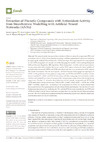Please use this identifier to cite or link to this item:
https://accedacris.ulpgc.es/jspui/handle/10553/114447
| Title: | Extraction of Phenolic Compounds with Antioxidant Activity from Strawberries: Modelling with Artificial Neural Networks (ANNs) | Authors: | Golpour, Iman Ferrao, Ana Cristina Goncalves, Fernando Correia, Paula M. R. Blanco-Marigorta, A. M Guine, Raquel P. F. |
UNESCO Clasification: | 3303 ingeniería y tecnología químicas 3206 Ciencias de la nutrición |
Keywords: | Strawberry Total phenolic compounds Antioxidant activity Artificial neural networks (ANNs) |
Issue Date: | 2021 | Project: | UIDB/00681/2020 CI&DETS/2015/0004 UIDB/00681/2020 |
Journal: | Foods | Abstract: | This research study focuses on the evaluation of the total phenolic compounds (TPC) and antioxidant activity (AOA) of strawberries according to different experimental extraction conditions by applying the Artificial Neural Networks (ANNs) technique. The experimental data were applied to train ANNs using feed-and cascade-forward backpropagation models with Levenberg-Marquardt (LM) and Bayesian Regulation (BR) algorithms. Three independent variables (solvent concentration, volume/mass ratio and extraction time) were used as ANN inputs, whereas the three variables of total phenolic compounds, DPPH and ABTS antioxidant activities were considered as ANN outputs. The results demonstrate that the best cascade-and feed-forward backpropagation topologies of ANNs for the prediction of total phenolic compounds and DPPH and ABTS antioxidant activity factors were the 3-9-1, 3-4-4-1 and 3-13-10-1 structures, with the training algorithms of trainlm, trainbr, trainlm and threshold functions of tansig-purelin, tansig-tansig-tansig and purelin-tansig-tansig, respectively. The best R2 values for the predication of total phenolic compounds and DPPH and ABTS antioxidant activity factors were 0.9806 (MSE = 0.0047), 0.9651 (MSE = 0.0035) and 0.9756 (MSE = 0.00286), respectively. According to the comparison of ANNs, the results showed that the cascade-forward backpropagation network showed better performance than the feed-forward backpropagation network for predicting the TPC, and the FFBP network, in predicting the DPPH and ABTS antioxidant activity factors, had more precision than the cascade-forward backpropagation network. The ANN technique is a potential method for estimating targeted total phenolic compounds and the antioxidant activity of strawberries. | URI: | https://accedacris.ulpgc.es/handle/10553/114447 | ISSN: | 2304-8158 | DOI: | 10.3390/foods10092228 | Source: | Foods [ISSN 2304-8158], v. 10 (9), 2228 |
| Appears in Collections: | Artículos |
SCOPUSTM
Citations
14
checked on Jun 8, 2025
WEB OF SCIENCETM
Citations
9
checked on Jun 8, 2025
Page view(s)
100
checked on Dec 21, 2024
Download(s)
36
checked on Dec 21, 2024
Google ScholarTM
Check
Altmetric
Share
Export metadata
Items in accedaCRIS are protected by copyright, with all rights reserved, unless otherwise indicated.
